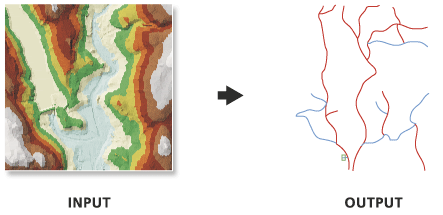Resumen
Exporta líneas de corte desde un dataset de red irregular de triángulos (TIN) a una clase de entidad de línea 3D.
Ilustración

Uso
Las líneas de salida se atribuyen con valores enteros que identifican cada tipo de línea de corte. Estos códigos se almacenan en un campo cuyo nombre lo define el parámetro Campo de código, y el significado de los valores se define a continuación:
- 1—Línea de corte fina, que representa los cambios graduales en la pendiente.
- 2—Línea de corte gruesa, que representa los cambios abruptos en la pendiente.
El TIN debe tener líneas de corte para que esta herramienta produzca entidades de línea. Si se desea obtener los bordes del triángulo, independientemente de las líneas de corte, considere la posibilidad de usar la herramienta Arista del TIN.
Sintaxis
TinLine(in_tin, out_feature_class, {code_field})| Parámetro | Explicación | Tipo de datos |
in_tin | El dataset de TIN que se va a procesar. | TIN Layer |
out_feature_class | La clase de entidad que generará esta herramienta. | Feature Class |
code_field (Opcional) | El nombre del campo en la clase de entidad de salida que define el tipo de línea de corte. El nombre de campo predeterminado es Código. | String |
Muestra de código
En el siguiente ejemplo se muestra cómo usar esta herramienta en la ventana de Python.
arcpy.env.workspace = 'C:/data'
arcpy.TinLine_3d('tin', 'tin_line.shp', code_field='BreakType')En el siguiente ejemplo se muestra cómo usar esta herramienta en un script independiente de Python.
"""****************************************************************************
Name: Create Terrain from TIN
Description: This script demonstrates how to create a terrain dataset using
features extracted from a TIN. It is particularly useful in
situations where the source data used in the TIN is not available,
and the amount of data stored in the TIN proves to be too large
for the TIN. The terrain's scalability will allow improved
display performance and faster analysis. The script is designed
to work as a script tool with 5 input arguments.
****************************************************************************"""
# Import system modules
import arcpy
# Set local variables
tin = arcpy.GetParameterAsText(0) # TIN used to create terrain
gdbLocation = arcpy.GetParameterAsText(1) # Folder that will store terran GDB
gdbName = arcpy.GetParameterAsText(2) # Name of terrain GDB
fdName = arcpy.GetParameterAsText(3) # Name of feature dataset
terrainName = arcpy.GetParameterAsText(4) # Name of terrain
try:
# Create the file gdb that will store the feature dataset
arcpy.management.CreateFileGDB(gdbLocation, gdbName)
gdb = '{0}/{1}'.format(gdbLocation, gdbName)
# Obtain spatial reference from TIN
SR = arcpy.Describe(tin).spatialReference
# Create the feature dataset that will store the terrain
arcpy.management.CreateFeatureDataset(gdb, fdName, SR)
fd = '{0}/{1}'.format(gdb, fdName)
# Export TIN elements to feature classes for terrain
arcpy.AddMessage("Exporting TIN footprint to define terrain boundary...")
boundary = "{0}/boundary".format(fd)
# Execute TinDomain
arcpy.ddd.TinDomain(tin, tinDomain, 'POLYGON')
arcpy.AddMessage("Exporting TIN breaklines...")
breaklines = "{0}/breaklines".format(fd)
# Execute TinLine
arcpy.ddd.TinLine(tin, breaklines, "Code")
arcpy.AddMessage("Exporting TIN nodes...")
masspoints = "{0}/masspoints".format(fd)
# Execute TinNode
arcpy.ddd.TinNode(sourceTIN, TIN_nodes)
arcpy.AddMessage("Creating terrain dataset...")
terrain = "terrain_from_tin"
# Execute CreateTerrain
arcpy.ddd.CreateTerrain(fd, terrainName, 10, 50000, "",
"WINDOWSIZE", "ZMEAN", "NONE", 1)
arcpy.AddMessage("Adding terrain pyramid levels...")
terrain = "{0}/{1}".format(fd, terrainName)
pyramids = ["20 5000", "25 10000", "35 25000", "50 50000"]
# Execute AddTerrainPyramidLevel
arcpy.ddd.AddTerrainPyramidLevel(terrain, "", pyramids)
arcpy.AddMessage("Adding features to terrain...")
inFeatures = "{0} Shape softclip 1 0 10 true false boundary_embed <None> "\
"false; {1} Shape masspoints 1 0 50 true false points_embed "\
"<None> false; {2} Shape softline 1 0 25 false false lines_embed "\
"<None> false".format(boundary, masspoints, breaklines)
# Execute AddFeatureClassToTerrain
arcpy.ddd.AddFeatureClassToTerrain(terrain, inFeatures)
arcpy.AddMessage("Building terrain...")
# Execute BuildTerrain
arcpy.ddd.BuildTerrain(terrain, "NO_UPDATE_EXTENT")
arcpy.GetMessages()
except arcpy.ExecuteError:
print(arcpy.GetMessages())
except Exception as err:
print(err)Entornos
Información de licenciamiento
- Basic: Requiere 3D Analyst
- Standard: Requiere 3D Analyst
- Advanced: Requiere 3D Analyst